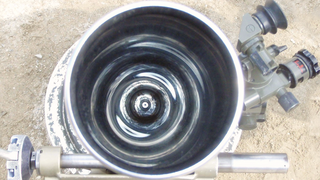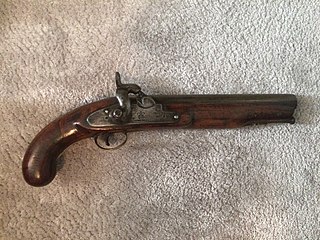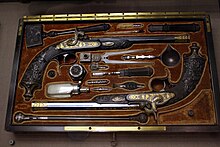
A firearm is any type of gun designed to be readily carried and used by an individual. The term is legally defined further in different countries.

A rifle is a long-barreled firearm designed for accurate shooting and higher stopping power, with a barrel that has a helical pattern of grooves (rifling) cut into the bore wall. In keeping with their focus on accuracy, rifles are typically designed to be held with both hands and braced firmly against the shooter's shoulder via a buttstock for stability during shooting. Rifles are used extensively in warfare, law enforcement, hunting, shooting sports and crime.

In firearm designs, the term single-shot refers to guns that can hold only a single round of ammunition inside and thus must be reloaded manually after every shot. Compared to multi-shot repeating firearms ("repeaters"), single-shot designs have no moving parts other than the trigger, hammer/firing pin or frizzen, and therefore do not need a sizable receiver behind the barrel to accommodate a moving action, making them far less complex and more robust than revolvers or magazine/belt-fed firearms, but also with much slower rates of fire.
A muzzleloader is any firearm, in which the user loads the projectile and the propellant charge into the muzzle end of the gun. This is distinct from the modern designs of breech-loading firearms, in which user loads the ammunition into the breech end of the barrel. The term "muzzleloader" applies to both rifled and smoothbore type muzzleloaders, and may also refer to the marksman who specializes in the shooting of such firearms. The firing methods, paraphernalia and mechanism further divide both categories as do caliber.

Rifling is the term for helical grooves machined into the internal surface of a firearms's barrel for imparting a spin to a projectile to improve its aerodynamic stability and accuracy. It is also the term for creating such grooves.

Flintlock is a general term for any firearm that uses a flint-striking ignition mechanism, the first of which appeared in Western Europe in the early 16th century. The term may also apply to a particular form of the mechanism itself, also known as the true flintlock, that was introduced in the early 17th century, and gradually replaced earlier firearm-ignition technologies, such as the matchlock, the wheellock, and the earlier flintlock mechanisms such as the snaplock and snaphaunce.

A derringer is a small handgun that is neither a revolver, semi-automatic pistol, nor machine pistol. It is not to be confused with mini-revolvers or pocket pistols, although some later derringers were manufactured with the pepperbox configuration. The modern derringer is often multi-barreled, and is generally the smallest usable handgun of any given caliber and barrel length due to the lack of a moving action, which takes up more space behind the barrel. It is frequently used by women because it is easily concealable in a purse or a stocking.

The pepper-box revolver or simply pepperbox is a multiple-barrel firearm, mostly in the form of a handgun, that has three or more gun barrels in a coaxially revolving mechanism. Each barrel holds a single shot, and the shooter can manually rotate the whole barrel assembly to sequentially index each barrel into alignment with the lock or hammer, similar to rotation of a revolver's cylinder.

A smoothbore weapon is one that has a barrel without rifling. Smoothbores range from handheld firearms to powerful tank guns and large artillery mortars.

A gun barrel is a crucial part of gun-type weapons such as small firearms, artillery pieces, and air guns. It is the straight shooting tube, usually made of rigid high-strength metal, through which a contained rapid expansion of high-pressure gas(es) is used to propel a projectile out of the front end (muzzle) at a high velocity. The hollow interior of the barrel is called the bore, and the diameter of the bore is called its caliber, usually measured in inches or millimetres.

The lock of a firearm is the mechanism used to initiate firing. It is a historical term, in that it generally refers to such mechanisms used in muzzle-loading and early breech-loading firearms. Side-lock refers to the type of construction, in which the individual components of the mechanism are mounted either side of a single plate. The assembly is then mounted to the stock on the side of the firearm. In modern firearm designs, the mechanism to initiate firing is generally constructed within the frame or receiver of the firearm and is referred to as the firing or trigger mechanism.
A rifled musket, rifle musket, or rifle-musket is a type of firearm made in the mid-19th century. Originally the term referred only to muskets that had been produced as a smoothbore weapon and later had their barrels replaced with rifled barrels. The term later included rifles that directly replaced, and were of the same design overall as, a particular model of smoothbore musket.

The M1819 Hall rifle was a single-shot breech-loading rifle designed by John Hancock Hall, patented on May 21, 1811, and adopted by the U.S. Army in 1819. It was preceded by the Harpers Ferry M1803. It used a pivoting chamber breech design and was made with either flintlock or percussion cap ignition systems. The years of production were from the 1820s to the 1840s at the Harpers Ferry Arsenal. This was the first breech-loading rifle to be adopted in large numbers by any nation's army, but not the first breech-loading military rifle – the Ferguson rifle was used briefly by the British Army in the American Revolutionary War. The Hall rifle remained overshadowed by common muskets and muzzleloading rifles which were still prevalent until the Civil War. The early flintlocks were mostly converted to percussion ignition.
Thompson/Center Arms was an American firearms company based in Springfield, Massachusetts. The company was best known for its line of interchangeable-barrel, single-shot pistols and rifles. Thompson/Center also manufactured muzzle-loading rifles and was credited with creating the resurgence of their use in the 1970s.

A handgun is a firearm designed to be usable with only one hand. It is distinguished from a long gun which needs to be held by both hands and braced against the shoulder. Hand guns have a shorter range compared to the long guns. The two most common types of handguns are revolvers and semi-automatic pistols, although other types such as derringers and machine pistols also see infrequent usage.

The model 1805 U.S. Marshal "Harper's Ferry" flintlock pistol, manufactured at the Harpers Ferry Armory in Virginia, was the first pistol manufactured by an American national armory. It was the standard handgun of the US dragoons during the War of 1812.
The Minié rifle was an important infantry rifle of the mid-19th century. A version was adopted in 1849 following the invention of the Minié ball in 1847 by the French Army captain Claude-Étienne Minié of the Chasseurs d'Orléans and Henri-Gustave Delvigne. The bullet was designed to allow rapid muzzle loading of rifles and was an innovation that brought about the widespread use of the rifle as the main battlefield weapon for individual soldiers. The French adopted it following difficulties encountered by the French army in North Africa, where their muskets were overtaken in range by long-barreled weapons which were handcrafted by their Algerian opponents. The Minié rifle belonged to the category of rifled muskets.

The Kalthoff repeater was a type of repeating firearm that was designed by members of the Kalthoff family around 1630, and became the first repeating firearm to be brought into military service. At least nineteen gunsmiths are known to have made weapons following the Kalthoff design. Some early Kalthoff guns were wheellocks, but the rest were flintlocks. The capacity varied between 5 and 30 rounds, depending on the style of the magazines. A single forward and back movement of the trigger guard, which could be done in 1–2 seconds, readied the weapon for firing. The caliber of Kalthoff guns generally varied between 0.4–0.8 in (10–20 mm), though 0.3 in (7.6 mm) caliber examples also exist.
The following are terms related to firearms and ammunition topics.

A pistoleer is a mounted soldier trained to use a pistol, or more generally anyone armed with such a weapon. It is derived from pistolier, a French word for an expert marksman.



















